Ibis Oso 1.1
Wheel Size: 29’’ front / 27.5” rear (Sizes S–M), 29’’ (Sizes L–XL)
Suspension Travel:
- Frame: 155 mm
- Fork: 170 mm
Geometry Highlights:
- Sizes Offered: S, M, L, XL
- Headtube Angle: 64°
- Reach: 500 mm (size Large)
- Chainstay Length: 444 mm (size Large)
Drive System Highlights:
- Motor: Bosch Performance Line CX (Gen 4)
- Torque: 85 Nm
- Power: 600 W
- Battery: 750 Wh (625 Wh on size Small)
- Display: Bosch System Controller
- Remote: Bosch Mini Remote
Frame Material: Carbon fiber
Price: $5,999 USD
Blister’s Measured Weight: 54.86 lbs / 24.88 kg (size Large, with pedals)
Reviewer: 6’, 165 lbs / 183 cm, 74.8 kg
Test Locations: Washington
Test Duration: 3 mont55
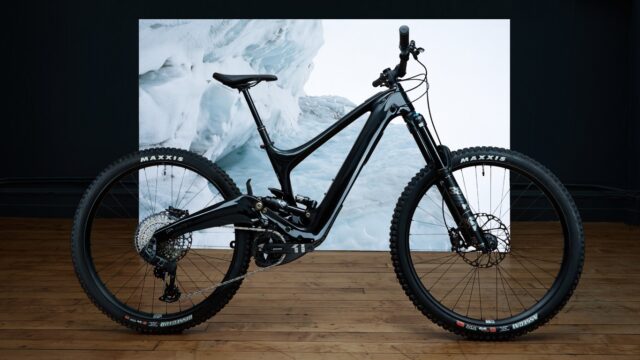
Intro
Oso means ‘bear’ in Spanish, a name that seems to suit the burly intentions of Ibis’ long-travel eMTB. The original Oso was released back in 2022, and Ibis has learned a thing or two after seeing that bike romp in the woods for a couple of years. So while the new Oso 1.1 looks the same as its predecessor, there are a lot of small tweaks under the hood, along with a very compelling new price tag.
Check out our rundown of the design details and our Full Review after a few months with the Oso 1.1.

The Frame
Ibis used the shaping potential of carbon fiber to indulge in some retrofuturism with first Oso, with the flowing lines of its asymmetric front triangle and large elevated swingarm. Those general design cues continue, but I had a chance to meet with Ibis’ Product Manager on the Oso project to learn more about how rider feedback steered the Oso 1.1’s updates.
First, Ibis took another look at the Oso’s carbon layup. Despite its large diameter tubes, the team at Ibis felt that the bike’s aggressive personality could benefit from increased stiffness. A new layup brings more rigidity throughout the frame, while the rear end remains intentionally less stiff to allow better tracking and grip. Ibis also decided to double the thickness of the downtube and motor guards while also upgrading to a tougher material, granting greater impact protection for the frame and the motor. The frame still carries a lifetime warranty, along with a lifetime bushing warranty for the pivots.
Using the onboard battery to power auxiliary lights makes a lot of sense, but the first Oso’s pre-installed headlight and taillight proved a bit polarizing. Ibis heard the calls for optionality, and while the Oso 1.1 still comes with both Lupine lights, only the Lupine C14 taillight comes installed. The Oso 1.1 is pre-wired for the Lupine SL F Nano 900 lumen headlight, which can be easily mounted up and plugged in for buyers who want it, or left off for buyers who don’t. The 45-lumen C14 taillight can also be removed, but it’s part of the seatpost collar, so you’ll need to source a new one if you decide to remove it. While the 900-lumen headlight is likely not quite bright enough for true night riding, it’s a great option for sunset laps or safety on the commute home from the trails.

There are some other tweaks to mention in the drive system section below, but otherwise, the frame is the same as the original Oso. That means the same compact DW-Link suspension layout delivering 155 mm of travel (which happens to remind me very much of the DW-Link version of the Turner DHR), and a 25% rate of progression in the leverage rate means that coil shocks are compatible too, as long as the reservoir is short enough to clear the frame. I’ll be experimenting with some other options during our test, but I’ve confirmed with Ibis that the Fox DHX2 fits just fine.
Drive System
Folks looking for the latest and greatest Bosch motor may be surprised to see the prior Gen 4 version of their Performance Line CX unit on the Oso 1.1. That prior motor was still arguably the best in class, and its use here is undoubtedly a bit part of the Oso 1.1’s very appealing price point. It still has the same core output statistics as the newer Gen 5 system, with 600 W of peak power and 85 Nm of torque, with the primary differences in the new motor being a lower weight and quieter operation, along with some tweaks to sensitivity.
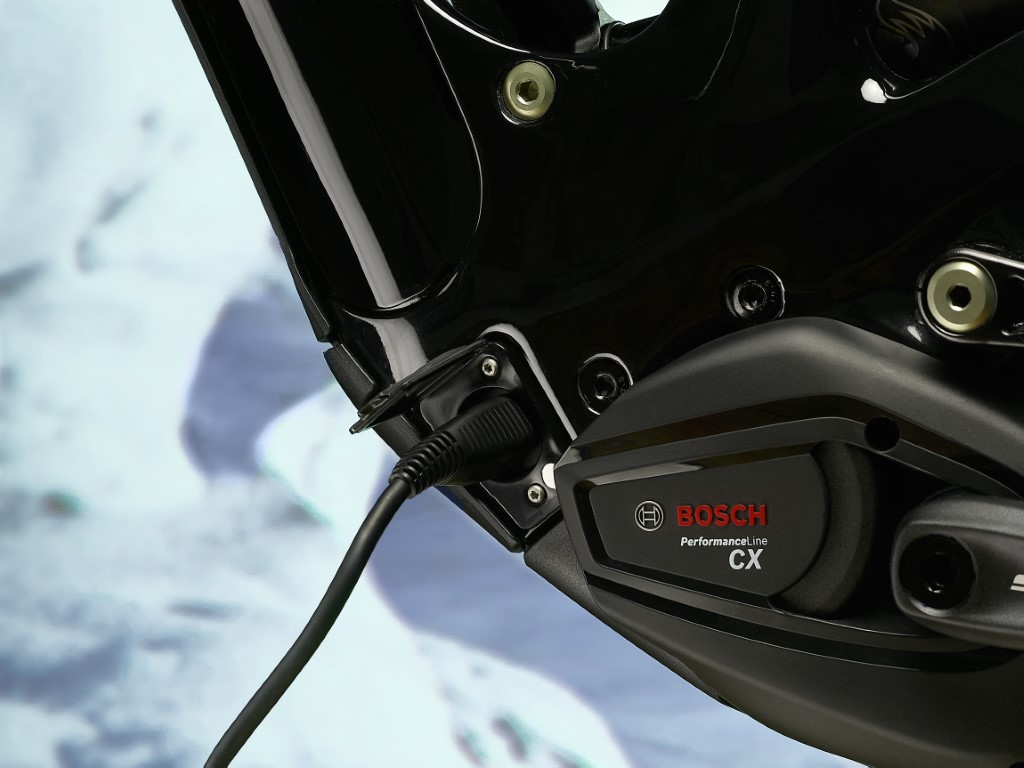
While using the older motor means that it doesn’t get the newer batteries either, the 750 Wh battery should offer plenty of range for most folks — though smaller riders should note that the size Small gets a 625 Wh battery given space constraints. The battery can be swapped quite quickly too, thanks to a plastic door on the non-drive side of the frame. A twist of an Allen bolt removes the door, and another Allen bolt retains the battery.
The prior Oso has a lot going on in the cockpit area thanks to a wired controller and the large wired Kiox display, but that’s been addressed as well. Bosch’s System Controller unit is now nested into the top tube, and the wireless Mini Remote removes yet another cable.
It’s also worth noting that Ibis now has an in-house Bosch expert that can help both domestic and international customers should any system issues arise down the line.
Fit & Geometry
The geometry matches that of the prior Oso, which is perhaps on the longer end of things for a given nominal size. A size Large has a full 500 mm reach, which Ibis recommends as the suggested size for folks between 5’7’’ and 6’1’’ tall. That is quite a bit longer than average for the size, and a full 40 mm longer than the Medium’s 460 mm reach figure. That lengthy reach is mated to a 64° head tube angle, an also-long 638 mm effective top tube, tall 650 mm stack, and 444 mm chainstays for the 29’’ rear wheel. Shorter 434 mm chainstays are used with the Small and Medium’s 27.5’’ rear wheel. While the Large and XL can run a smaller 27.5’’ rear wheel as well, that change requires buying a whole new rear triangle.
At a glance, the size Large looks like it’s treading in XL territory thanks to the rather significant gaps between sizes. My first impression is that the gaps appear a bit too large, particularly when jumping from Medium to Large, or Large to XL (which has a massive 540 mm reach, 669 mm effective top tube, and 665 mm stack height).
As we’ve said many times over, the fit of a bike doesn’t always come across perfectly in the geometry, so we’ll have to see how the Oso 1.1 feels in practice before we judge the sizing.
Full geometry figures are as follows:
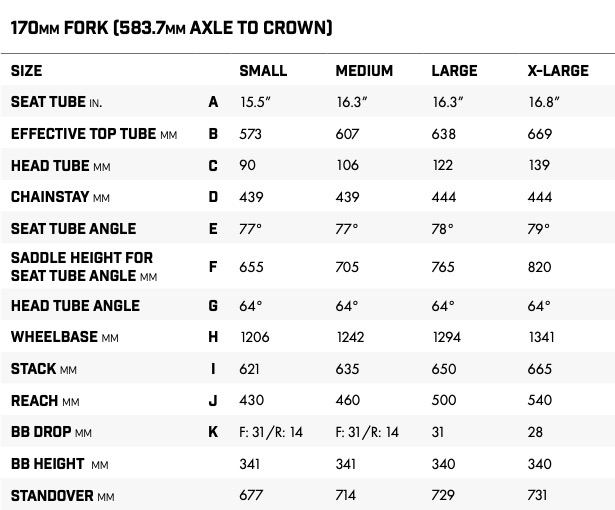
The Build
As with the prior Oso, the Oso 1.1 has just one build on offer — and it’s basically the same as the prior one, just a lot cheaper. $5,999 USD gets you a Fox 38 Performance fork and X2 Performance Elite shock, Shimano XT 4-piston brakes, GX Transmission from SRAM, and Ibis’ house brand Blackbird Send wheels, which are backed with a lifetime warranty and crash replacement policy. It’s a somewhat unconventional collection of parts from brands that don’t often get mixed (SRAM and Shimano), but it’s a very solid build — especially so for that price.

Ibis has nailed some of the finishing details for a burly eMTB, with 220 mm rotors front and rear (hey, it’s a big bike after all), and Maxxis Assegai front and DHR II rear tires, both in Downhill casing with the MaxxGrip compound. Ibis uses their own house brand finishing parts, with a 30 mm rise bar and stem lengths that vary by size — though the 50 mm stem used on the Large and XL sizes feels oddly long for an aggressive eMTB like the Oso 1.1, especially given the reach lengths on those sizes.
Full build details are as follows:
- Drivetrain: SRAM GX Transmission
- Brakes: Shimano XT (220 mm rotors)
- Fork: Fox 38 Performance (170 mm)
- Shock: Fox X2 Performance Elite
- Wheels: Blackbird Send I / Send II
- Dropper Post: Bike Yoke Revive (S: 125 mm, M: 160 mm, L: 185 mm, XL: 213 mm
FULL REVIEW
The Ibis Oso has been around for a couple of years now, but it still doesn’t look like anything else on the market. The Oso 1.1 keeps the same overall design of the original, but Ibis has made some meaningful changes to improve stiffness in the front triangle, reduce cable clutter, and improve frame protection. That all comes at a very compelling price point, too — but how does it perform? We’ve spent a few months finding out.

Fit & Sizing
Looking at the geometry chart for the size Large Oso 1.1, it’s quite clear that this is a big, burly bike. The 500 mm reach is a good bit longer than an average Large, as is the 638 mm effective top tube, and the tall 650 mm stack makes for a tall front end, too. Paired with the 64° head tube angle and 444 mm chainstays on the Large, that all adds up to a lengthy 1,294 mm wheelbase.
While I was slightly concerned about the fit being too big for my 6’0’’ stature, I actually found that the Oso didn’t feel as unwieldy as I might have expected. It’s a big bike, to be sure, but once I swapped the stock 50 mm stem for a 40 mm one, I actually found that it simply felt roomy rather than categorically too big. That said, I do think I might have preferred a slightly shorter reach to help make the Oso feel more maneuverable and engaging at lower speeds. While I was able to adapt fairly easily to the bike’s proportions, the dimensions of the Large Oso 1.1 have a significant impact on how it handles and the terrain that it prefers — more on that below.
Buyers should note that the size jumps on either end of the Large are big enough that I can’t imagine that most folks will be tempted to size up or down — there are full 40 mm jumps in the reach measurement, either down to the Medium or up to the XL. The XL is a truly massive bike with a 669 mm top tube, 540 mm reach, and 1341 mm wheelbase. As mentioned above, dropping down to a Medium would also mean a smaller 27.5’’ rear wheel and shorter 434 mm chainstays, resulting in a full 52 mm reduction in the wheelbase.

Those size differences are, in my opinion, a bit too big. I would wager that some folks who typically find themselves on the fence — between a Medium and Large, for example — may feel like they’re in no-man’s land between the rather big Large or more average Medium. I also think that Ibis is reaching a bit in saying that folks between 5’7’’ and 6’1’’ should be on a Large. A 5’7’’ rider would almost undoubtedly find the Large to be a lot of bike for their height, and if you asked me to build a size chart, my guidance would generally be that the Large be considered by folks between 5’10’’ and 6’2’’ or so.
Ibis has introduced the “Extra Medium” size on some of the other bikes in their range to help fill the gap between the Medium and Large, and that would be a welcome addition for the Oso as well.
Climbing
The Oso 1.1 is a full-power eMTB, and it climbs like one. The Bosch CX motor is impressive in its power delivery, feeling both amply powerful while also having a lot of sensitivity for climbing in more technical terrain. The motor is still the older fourth-generation Bosch CX Performance Line unit, and while the new fifth-generation version purports to be lighter and quieter, the fourth-generation one is still very good in how natural its power delivery feels. I’ll talk a bit more about the Bosch system in the Drive System section later in the review.
The Oso 1.1 generates a ton of traction, aided by its sensitive rear suspension and the sticky Maxxis DHR2 rear tire in a MaxxGrip casing. The rear tire is already showing a lot of wear, which is to be expected for such a soft compound, but the performance in areas where traction is at a premium is pretty damn impressive.
While a number of newer eMTBs like the Santa Cruz Bullit seem to be opting for smaller battery sizes to bring the weight down (while offering a range extender option), the Oso sticks with a big 750 Wh unit. I never fully killed the battery, and though I got close on a couple of occasions, my friends on other bikes always seemed to run out well before I did. Of course, the big battery was a major driver behind the rather hefty 54.86 lbs / 24.88 kg weight with pedals, and while all that juice is nice for tearing up fire roads for as many laps as possible, it does make the Oso a bit uninspiring and cumbersome on more tight, technical climbs.
The big wheelbase is also partly to blame there, and between the Oso’s weight and length, switchbacks and sections requiring lots of precision in wheel placement were quite a challenge. Given the Oso’s handling on the way back down, potential buyers will likely be fine with that tradeoff, but it’s worth mentioning that despite having 155 mm of rear wheel travel, the Oso seems very much a burly “self-shuttle” bike rather than a more all-rounder eMTB.

Descending
In both its geometry and build, the Oso 1.1 is unapologetically biased toward downhill performance, and that’s certainly where it thrives. Even amongst more descent-oriented eMTBs, though, it comes with its own very distinct ride feel and preferences.
In conversations with Ibis, their team seems very proud of the suspension performance achieved on the Oso, and after a few months with the Oso 1.1, I wholeheartedly agree. My first few rides were on some very technical trails riddled with square-edged hits that abuse your body and challenge any tires to keep traction, but the Oso did a very impressive job of tracking the ground. While I already commented on the bike’s higher than average weight, I do think that all that sprung weight attributed to the motor and large battery helps to keep the Oso from getting knocked around, and it feels especially quiet and forgiving on really abusive trails.
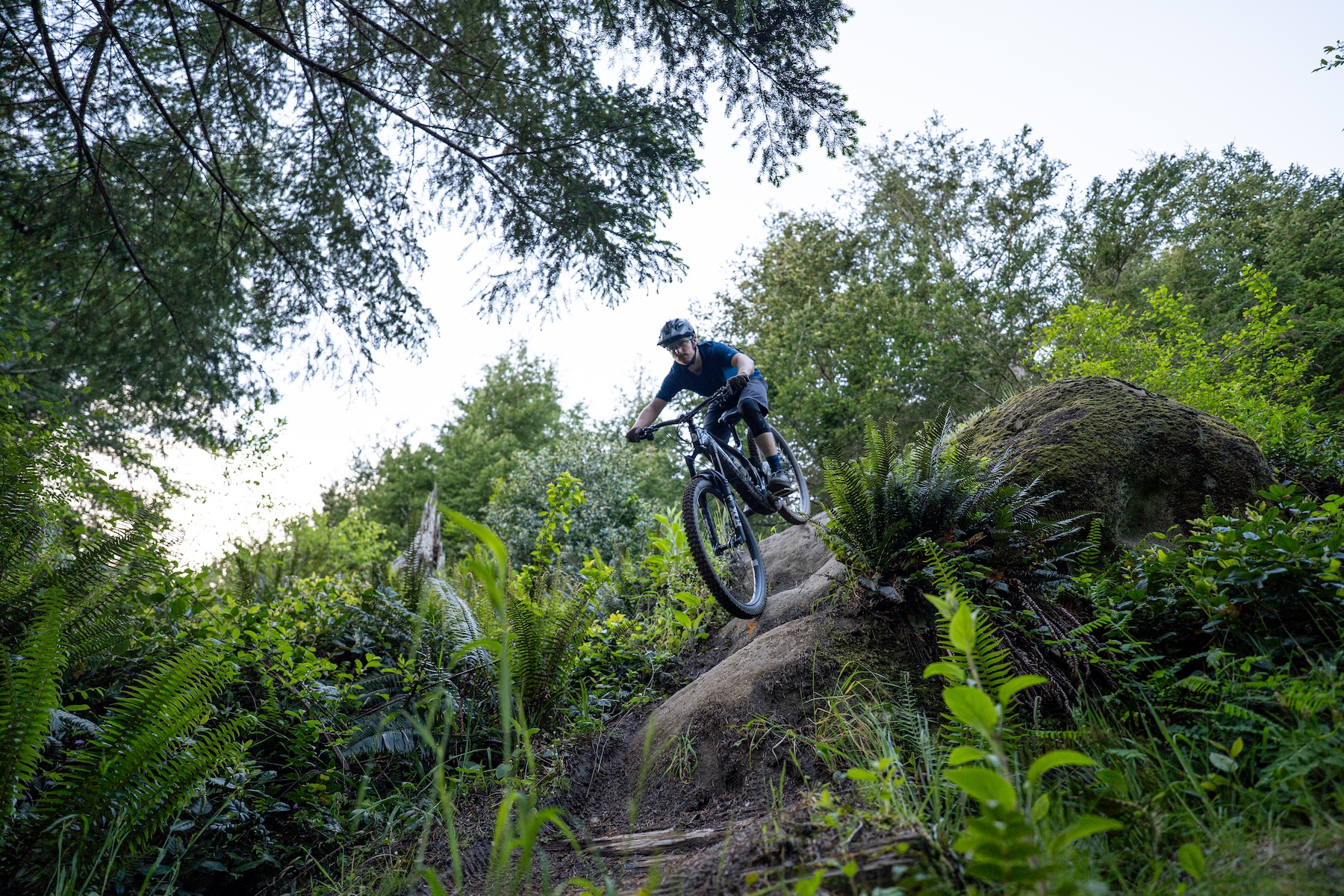
The Oso’s long wheelbase, lengthy reach, and tall stack all start to come into their own as speeds pick up. While I would have expected a bike with such a long reach and not-crazy-long chainstays to require a more forward body position, the weight of the battery in the downtube goes a long way towards keeping weight on the front wheel, allowing a tall, centered, and safe-feeling body position. I personally found the Oso to perform better and better as the pace pushed faster, with the rather compliant rear suspension and body position almost having the effect of slowing down my perception of how fast I was really going on some trails.
Another big part of this is the rather compliant rear end. While Ibis claims to have stiffened up the front triangle, the unique rear triangle design intentionally has a significant amount of torsional flex that allows the rear wheel to conform to the trail a bit more rather than deflecting like a stiffer chassis might. I mentioned this in my Flash Review, but the flex is extremely apparent even when grabbing the rear wheel and torquing it side to side, and it contributes a unique feel on the trail. Especially on slippery and uneven surfaces, the Oso was remarkably good at keeping rear wheel traction. Even when I expected the rear wheel to want to step out, it would often just keep on tracking. I haven’t ridden the original Oso and can’t speak to the impact of Ibis’ claimed improvements to front triangle stiffness, but the bike struck a good balance of always tracking well to the direction of the front wheel while also allowing the rear wheel to comply with the terrain.
As much as all of those traits benefit the Oso at higher speeds, they come with some compromises when it comes to riding more dynamically. The 155 mm of rear travel doesn’t necessarily feel like more than its stated amount, but it still seems to want to track the ground more than it wants to pop off obstacles. The rear triangle’s torsional flex that keeps the chassis feeling so composed and grippy also robs the bike of some snappiness, which is most noticeable when trying to change directions quickly or drive the rear end into supported corners for some bonus speed. The ultimate effect is that the Oso can feel lumbering in terrain that requires a lot of dynamic inputs or demands particularly precise line choice, preferring to run over obstacles rather than dodge around them.
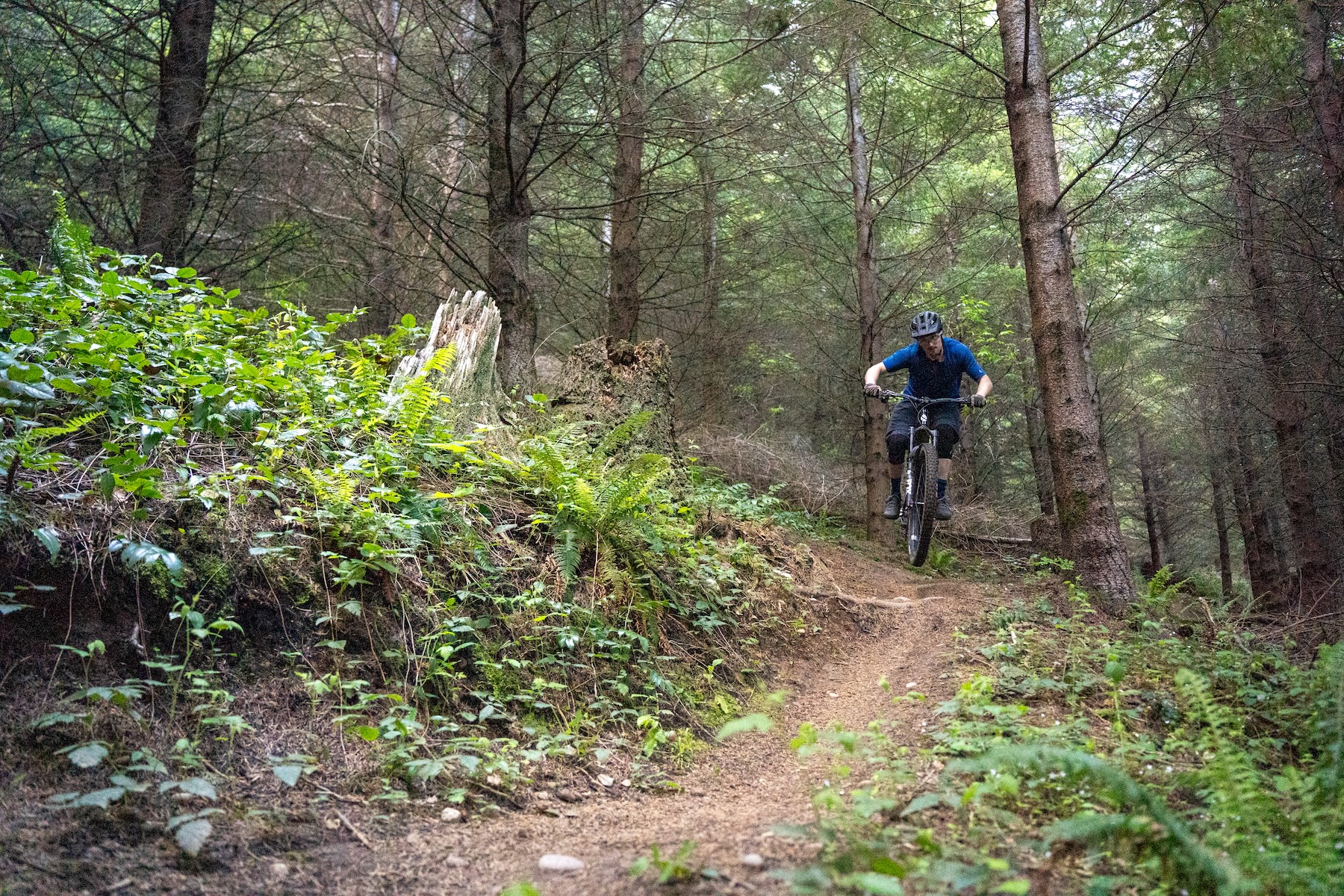
I also tend to find that heavier eMTBs come with significant compromises over lighter ones in really steep terrain. Traction is the key to survival in steeper terrain, and the Oso seemed to push both the brakes and tires to their limit a bit more quickly than some lighter eMTBs, requiring more precise braking and slightly lower entry speeds into steep sections to keep things in check. Burlier brakes might help with quicker deceleration in some cases (more on that later), but other heavier eMTBs suffer some of the same tendencies to understeer that the Oso exhibited.
While the weight carries compromises, I’m not so sure that investing in lighter components here or there would have that much of an effect on the Oso’s performance — a lot of the weight comes down to the big battery and frame. That weight also pays some dividends at higher speeds. Ultimately, its impressive poise in rough terrain is easy to appreciate, but the Oso prefers having some room to run to feel at its best.
Drive System and Range
The fourth-generation Bosch CX Performance Line motor isn’t the latest and greatest, but it’s quite good. The Bosch app offers tuning options for each of the four pre-programmed modes, but I stuck with the stock configuration and spent most of my time in the Eco and Tour+ modes, which are the lower power options. While multiple parameters can be adjusted within each mode, I find the additional motor overrun (where it continues to supply power after you stop pedaling) can be a bit excessive in the higher power eMTB and Turbo modes. While those more powerful modes are nice on faster fire road ascents, climbing technical singletrack on the already big-feeling Oso is much easier to manage in the lower power modes.
As was expected, the range of the 750 Wh battery is ample for most rides. I did a number of rides pushing 20 miles and well over 4,000 feet of elevation gain while finishing with battery life to spare. Most of those rides saw significant use of Turbo mode, given that they often included multiple laps with extensive sections of fire road, so prospective buyers should feel quite confident in the Oso’s ability to mitigate range anxiety for longer rides.
While I’m not sure it will be a regularly used feature, the battery is removable through a side-mounted door on the downtube. The door is plastic rather than carbon fiber and opens up with an Allen key, with another Allen key fastener securing the battery itself. The door feels a bit flimsy compared to the surrounding carbon fiber construction of the frame, but it didn’t rattle or otherwise cause performance issues.
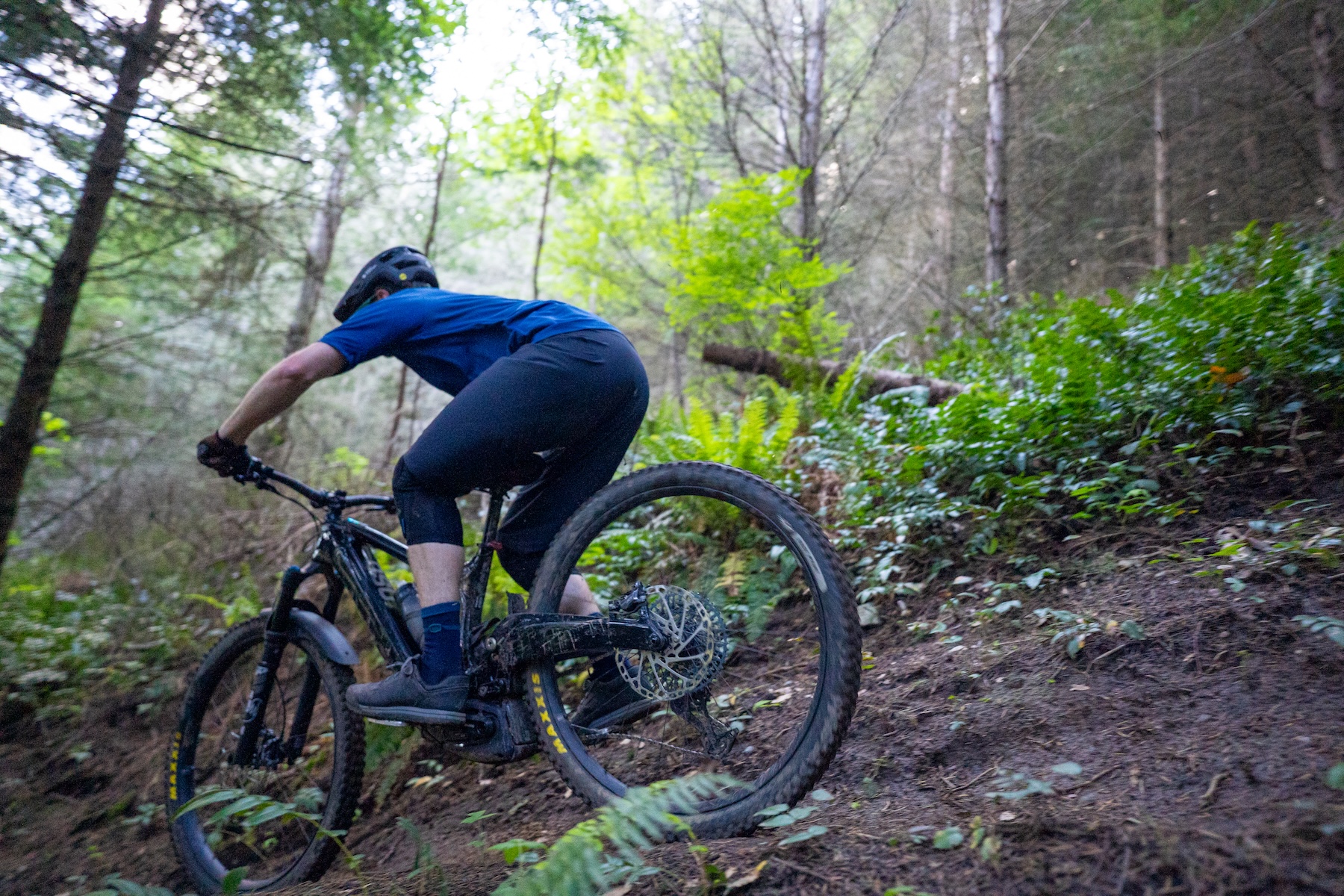
The Build
The Oso 1.1 comes with a nearly identical build to the prior Oso, and it’s a bit of an eclectic one. The blend of parts seems a bit all over the place brand-wise, with Fox suspension mated to SRAM GX Transmission shifting, Shimano XT brakes, and a Bike Yoke Revive dropper. As random as the assortment may seem, it’s all proven equipment and was quite reliable through the test. I do have some highlights and lowlights, though.
Highlights-wise, the prior generation Fox Float X2 rear shock felt well-suited to the Oso’s supple rear suspension and catered to its grippy, ground-hugging nature. The SRAM GX Transmission drivetrain worked without a hiccup throughout the test, despite the rear derailleur catching a few rocks at speed. I also found the Ibis Blackbird Send wheels to be comfortable and compliant, and they are still running true after some heavy hits. I also really enjoyed Ibis’ choice to spec DH-casing tires from Maxxis in their stickiest MaxxGrip compound, as the damping of the thick casing seemed to suit the heavier weight of the Oso while the compound delivered massive grip — just don’t expect them to last long with such sticky rubber.
In terms of parts I didn’t quite get along with, the four-piston Shimano XT brakes didn’t feel quite up to snuff on such a heavy bike. The 220 mm Shimano RT66 rotors front and rear certainly help eke out more power, but there are a number of brakes on the market now that simply outdo the XTs in their heat management and absolute power, both of which are of critical importance on a ~55 lb eMTB. The RT66 discs also don’t have the same higher-quality ground surface finish of some higher-end rotors, and I’d be willing to bet that an upgrade to some thicker rotors with a better surface finish might boost power a bit.
I also think it’s odd that Ibis supplies the Small and Medium builds with a 40 mm stem, but throws a 50 mm one on for the Large and XL. The reaches are so long that the 50 mm stem simply feels unnecessary from a fit perspective, and I preferred the handling with a 40 mm stem, too.
Beyond the parts spec, the frame itself seems well made, though the tight packaging of the rear suspension means that it takes an extra couple of steps to remove the rear shock. Dropper post insertion isn’t great given the interrupted seat tube, and I couldn’t run the 225 mm drop RockShox Reverb B1 that I’m testing, but the 185 mm drop of the Bike Yoke Revive was adequate if a bit shorter on drop than I prefer. The integrated lights attracted some questions from friends, and while I used them whenever riding around cars at twilight, I’d likely remove the lights in the long term just for the sake of reducing cable clutter coming from the headlight and the remote.

Who’s It For?
First and foremost, the Oso is for riders who live for the downhills. It’s easy to assume that all eMTBs cater to descending, but many of them also prioritize response on jumps or flatter trails. That’s decidedly not the Oso — it wants a steady diet of speed and rough terrain to come into its own.
That’s not to say that the Oso is purely for expert-level riders who love to push the limit, though. Rather, the Oso’s composure could be a game-changer for riders who aspire to keep up with their faster buddies on natural trails, but need a steady and confident steed to help push their speed boundaries. If speed on machine-built or bike park trails is the priority, the Oso will still lend confidence, but the Oso isn’t the most inspiring in how it responds to rider inputs when pumping for speed, snapping through corners, etc. Those sorts of trails won’t tap fully into the Oso’s advantages when it comes to grip and forgiveness on long, rough descents.
I also want to make a final note on sizing. I mentioned this before, but I really do feel that the gaps between each nominal size are too big, and will inherently create struggles for some riders who find themselves between sizes. Especially given the weight and ground-hugging persona of the Oso, I would encourage riders not to go purely by Ibis’ sizing recommendations and instead consider their typical reach preferences — and ideally at least get a lap around the parking lot on one at the local shop. If truly between sizes and value a bit more energy out of a bike’s handling, I might even consider sizing down rather than up, as a smaller bike may help to make the Oso’s weight feel a bit more manageable.
Bottom Line
The Oso 1.1 doesn’t have the shiniest new drive system or top-step parts, but it brings grippy rear suspension and a calm dynamic when riding at high speeds. It also rings in at a very compelling price. In a world of ever-lighter full power eMTBs, the Oso isn’t on the bleeding edge, but its sizable battery, confident geometry, and ground-hugging suspension make it a great option for riders who like to burn a lot of laps and might also need that extra nudge to go a little faster when things get rough.
